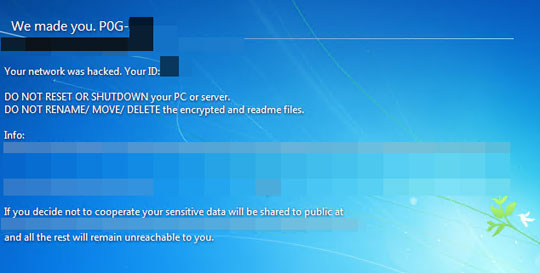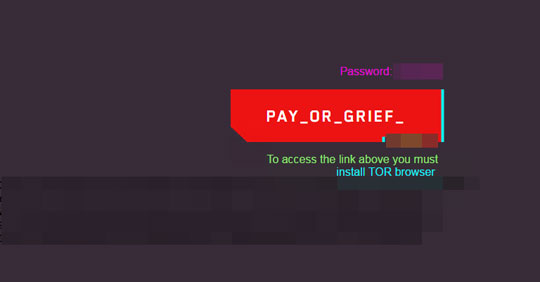Ransom.Win32.GRIEF.A
Windows


Threat Type: Ransomware
Destructiveness: No
Encrypted: Yes
In the wild: Yes
OVERVIEW
Downloaded from the Internet, Dropped by other malware
This Ransomware arrives on a system as a file dropped by other malware or as a file downloaded unknowingly by users when visiting malicious sites.
It drops files as ransom note.
TECHNICAL DETAILS
231,936 bytes
DLL
Yes
30 Aug 2021
Encrypts files, Executes files, Terminates processes, Modifies system registry, Drops files, Displays message/message boxes
Arrival Details
This Ransomware arrives on a system as a file dropped by other malware or as a file downloaded unknowingly by users when visiting malicious sites.
Installation
This Ransomware adds the following processes:
- vssadmin.exe Delete Shadows /All /Quiet
- bcdedit.exe /set {default} safeboot minimal
- bcdedit.exe /set {default} recoveryenabled No
- %System%\icacls.exe ":\*" /grant:r Everyone:F /t /c /q -> grant access to the drives it encrypts
(Note: %System% is the Windows system folder, where it usually is C:\Windows\System32 on all Windows operating system versions.)
Other System Modifications
This Ransomware adds the following registry entries:
HKEY_LOCAL_MACHINE\Software\Microsoft\
Windows\CurrentVersion\Policies\
System
LegalNoticeCaption = We made you. P0G-{number}
HKEY_LOCAL_MACHINE\Software\Microsoft\
Windows\CurrentVersion\Policies\
System
LegalNoticeText = 
Process Termination
This Ransomware terminates processes or services that contain any of the following strings if found running in the affected system's memory:
- sqlagent
- sophos
Other Details
This Ransomware does the following:
- It expects itself to be executed as a service
- It installs itself as a service through modifying a service's ImagePath to point to itself and execute it along with its correct argument
- In these particular samples, there is currently no way to terminate processes. The embedded Process Hacker is not included in the ransomware samples, and it does not enumerate running processes
- It removes connections to network shared resources
- It requires a specific argument in order for it to proceed to its malicious routine
- It changes the password of every user to the following:
- JaR99"Zd!51E4ECAE7509C3130AC4D2AD949E171F
- It initiates a system reboot after its installation
Ransomware Routine
This Ransomware avoids encrypting files with the following strings in their file path:
- svsho*.exe
- schre*.bat
- V01.lo*
- V01.ch*
- V01res*.jrs
- RacWmi*.sdf
- Web*V01.dat
- default.rdp
- NTUSER.DA*
- *.lnk
- *.ico
- *.ini
- *.msi
- *.chm
- *.sys
- *.hlf
- *.lng
- *.inf
- *.ttf
- *.cmd
- *.LNK
- *.ICO
- *.INI
- *.MSI
- *.CHM
- *.SYS
- *.HLF
- *.LNG
- *.INF
- *.TTF
- *.CMD
It avoids encrypting files found in the following folders:
- $RECYCLE.BIN
- $Recycle.Bin
- Caches
- WebCache
- VirtualStore
It appends the following extension to the file name of the encrypted files:
- .payorgrief
It drops the following file(s) as ransom note:
- {encrypted file name}.helpme.html - drops it for every file it encrypts

SOLUTION
9.800
16.944.04
03 Sep 2021
16.945.00
04 Sep 2021
Step 1
Trend Micro Predictive Machine Learning detects and blocks malware at the first sign of its existence, before it executes on your system. When enabled, your Trend Micro product detects this malware under the following machine learning name:
- Troj.Win32.TRX.XXPE50FFF050
Step 2
Before doing any scans, Windows 7, Windows 8, Windows 8.1, and Windows 10 users must disable System Restore to allow full scanning of their computers.
Step 3
Note that not all files, folders, and registry keys and entries are installed on your computer during this malware's/spyware's/grayware's execution. This may be due to incomplete installation or other operating system conditions. If you do not find the same files/folders/registry information, please proceed to the next step.
Step 4
Restart in Safe Mode
Step 5
Delete this registry value
Important: Editing the Windows Registry incorrectly can lead to irreversible system malfunction. Please do this step only if you know how or you can ask assistance from your system administrator. Else, check this Microsoft article first before modifying your computer's registry.
RESTOREStep 6
Enabling Volume Shadow Service
- Run the command prompt (cmd.exe) as administrator.
- Enable Volume Shadow Service by typing the following command:
net start vss
Step 7
Restart in normal mode and scan your computer with your Trend Micro product for files detected as Ransom.Win32.GRIEF.A. If the detected files have already been cleaned, deleted, or quarantined by your Trend Micro product, no further step is required. You may opt to simply delete the quarantined files. Please check this Knowledge Base page for more information.
Step 8
Restore encrypted files from backup.
Did this description help? Tell us how we did.

